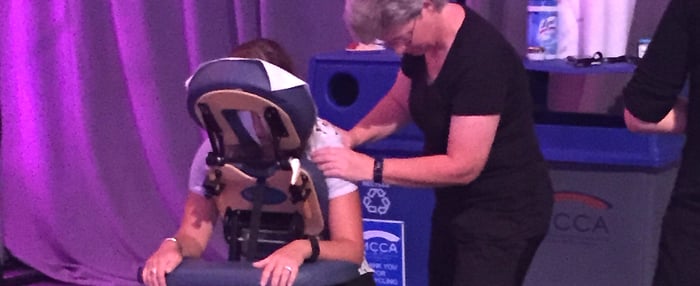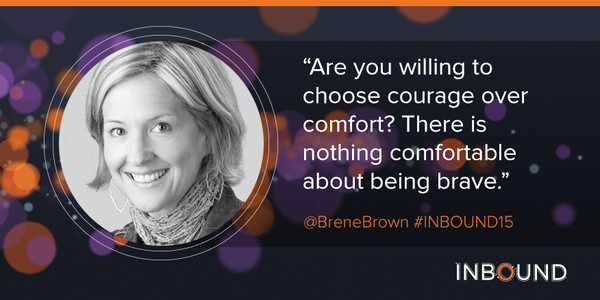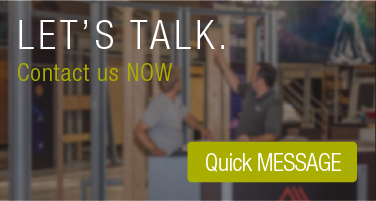55 Lessons Learned from Hubspot's INBOUND 2015 for Event Marketers
By Danielle DeBenedictis
A couple of weeks ago, I attended a conference held by Hubspot for marketing professionals interested in the "Inbound" methodology of marketing.
Inbound is about earning attention by telling stories and making connections about the things our target customers really care about in a relevant, timely, and customer-centric manner.

The conference, spanning across three days, involved 262 sessions and 8 keynote speakers, including such influential people as Seth Godin, Chelsea Clinton, Brené Brown and Aziz Ansari. So, as you can imagine, there was a lot of information to dive into.
As part of Sales & Marketing at Hill & Partners, I not only see the value in the inbound methodology for our own efforts, but it was clear how it could apply to those we work with each day - a variety of marketing professionals dealing with all types of events and brand awareness opportunities.
Sure, some of this information may be less than novel to experienced marketing professionals, but it serves to validate our efforts, frame a new perspective, and perhaps prompt some new ideas.
So here they are - The Key INBOUND Takeaways from start to finish in planning for your trade shows, events and other marketing efforts:
START WITH THE WHY
1) Set goals early, before starting anything else. Make sure they are SMART goals. Keep them simple then choose clear ways to measure and evaluate.
2) Understand your overall business goals. Marketing strategy is just an extension of business strategy, so if your efforts are not contributing to overall success, what's the point?
3) Define what success would look like for every stakeholder on the project.
4) The ultimate goal of marketing is to improve sales productivity.
5) Define your Learn Measure Builds (LMBs) - What do I want to learn from this experience? How are you going to measure that you learned it?
6) Risk-assess your LMBs right from the beginning to gauge progress. Is it the right learn for what you intend to deliver? Does it move you towards those SMART goals? Is it right measure to indicate achievement? Does it fit where you are at today?

UNDERSTAND YOUR AUDIENCE
7) Define audience segments relative to your SMART goals.
8) Rank the audience in terms of reach, resonance and relevance.
9) Listen to conversations about your company, your brand, and your competitors.
10) Get feedback from the target audience - Collect EBIs ("Even Better Ifs") - What really worked for you? What would make it better? What do you want more of? What do you want less of? - Nichole Kelly, CEO, Social Media Explorer
11) Map out how you ideally want your customer to consume the experience that you are creating. "What do you want your customers to become? What change do you want to create?" – Seth Godin, Marketing Guru

BUILD YOUR TEAM
12) Identify the right partners. Strategic partnerships drive our productivity and effectiveness further.
13) Communicate effectively. Create a "safe word" to signify when someone gets too overwhelmed and needs a moment to take a step back. - Karen Hartline, CEO, Reinventing Events
14) Don’t be afraid to have a CTJ (“Come To Jesus" meetings for when you need to get to the truth).
15) "You don't get responsibility, you take it. Strive to take responsibility and give credit." – Seth Godin
16) Get your sales team involved. A trade show or conference is not just a marketing thing. These are for sales leads. What type of space do they need to accomplish sales objectives?
17) Brainstorm individually first then as a group. Collaborate on ideas and be open to perspectives.
18) Put processes in place and standardize. Find new tools less time planning and more time doing and learning. Create templates and checklists and make sure your team uses them.
19) Focus Your Work. FYI: A study done at the University of London found that multi-tasking drops women's IQ by 5 points. It drops men's IQ by 15 points.

CREATE VALUE AT EVERY TOUCH
20) “This is an economy based on connection. Can you be heard, can you connect, can you be trusted?” – Seth Godin
21) Provide value at every touch. The goal should not be to get as many leads as possible. Create quality interactions to gather quality leads.
22) “The best sales reps in the future are actually marketers.”- Oliver Lopez, CEO of Structsales. They bring a lot of value to the table. Think like the client. Where are they coming from and where are they going from their perspective?
23) Appeal to what your audience already knows. Build off the familiar. Merge complexity and simplicity to make it harder for the brain to "look away." The brain is designed not to miss anything. People look away because they think they can predict what happens next. - Dr. Carmon Simon, Cognitive Neuroscientist
25) Always start with The Problem - People will seek out info that articulate solution to their problem. Do not start by talking about yourself. Attention drops off when it is not immediately relatable. Frame a problem that you have as a problem your audience has. - Tamsen Webster, CMO, Oratium
26) The Content Blueprint = Problem > Insight > Insight > Insight > Insight > Action
27) Find little bits of threads of interest and then amplify them.
28) Become a storyteller. Stories move us and motivate us to take action. Every company has amazing human stories. Find them and bring them to life.
29) Tell bolder stories. Take on a specific point of view. The biggest missed opportunity in content is playing it too safe. Content is an opportunity to do something different. Produce content that’s deeply educational, beyond listicles on a topic, where the voice reflects your culture, amplifies your story, and communicates with empathy. - Ann Handley, Chief Content Officer, MarketingProfs
30) "The purpose of a pitch is not to convert, it is to invite people into conversation." - Daniel Pink, best selling author on business management. A pitch should follow a format like every Disney story, using a 6 sentence narrative structure: 1) Once upon time there was 2) Every day 3) One day 4) Because of that 5) Because of that 6) Until finally...
31) There are negative business consequences to communicating the wrong message.

CREATE A MEMORABLE EXPERIENCE
32) DO - BELIEVE - KNOW (plan in this order). Ask first ‘what do I want them to do?’ Human action is preceded by belief. In order to act, the customer must believe that you will deliver on your promise, that they will receive a reward, and that they are ensured of safety or at minimal risk.
33) Knowledge drives belief. When presented with new piece of information, our brains first reach to connect in the context of things we already know. What does your audience need to believe in order to do it? What do they need to know before believe it? If the knowledge changes, the belief changes, then the action changes. - Tamsen Webster
34) Companies are increasingly judged on the experiences they provide. Recent research by Gartner found that 89% of companies expect to compete mostly on the basis of customer experience by 2016.
35) To stay in business means you have to stay in people’s minds. The Rexi Method states attention paves the way to memory, and people make decisions based on what they remember, which then leads to action. Attention > Memory > Decision = Action
36) Control what people remember. Do not leave it to chance. People tend to forget 90% of what is shared with them. Think about what the right 10% is for your customer to remember and gear the experience towards that.
37) Use change to draw attention, but keep 10% constant. The brain equates consistency with credibility. - Dr. Carmon Simon
38) Design to be Sharable. Can the experience be interpreted without it coming straight from you? Create easily repeatable content.
39) Start with this question: What is the most important message? Peak interest immediately by triggering your target to think and relate.
40) The benchmark for satisfaction is created from whatever is assumed to be provided by you. Exceed this level with a WOW factor.
41) Simplify. Don't make the person experiencing your Branded Environment think too much. Can you tell what you do and what the brand is about in 5 seconds or less? Focus more on essence and less on excess.
42) Add an element of surprise. The lasting effect is more profound in unexpected environments.
43) Reward behavior only 50% of the time. Building anticipation of a reward builds dopamine release, which heightens focus and memory.
44) Take the space where no one is talking and create the opposite of what is out there. "Shake Shack didn’t become a billion-dollar business while trying to be McDonald’s." - Seth Godin
DEVELOP BRAND ADVOCATES
45) Americans tell an average of 9 people about a good experience, and tell 16 (nearly 2x more) people about poor experiences.
46) Content is your brand because customer perception is your brand - and customer perception is most significantly shaped by content. - Tracey Wallace, Managing Editor, Bigcommerce
47) Trigger WOM: When the customer experience exceeds expectations they are likely to share it. This can be done architecturally - features that WOW or triggers recognition specific to brand or product; kinetically - performance level (usability, convenience, speed); generosity - giving amazing valuable content; and/or relatability - elements people can associate with. - Bryan Eisenberg, Author of 'Buyer Legends: The Executive Storyteller's Guide"
48) Change your perspective. We aren’t in business of ‘selling’ we are in business of helping customers buy. Deeper insights on your audience’s perspective produces better results.
49) Don't assume you know your audience. 70% of buying experiences are based on how the customer feels they are being treated. In one experiement, 80% of surveyed companies said they deliver ‘superior customer service,’ but when asking those same customers, only 8% thought that same service was superior.
MEASURE FOR CONTINUOUS IMPROVEMENT
50) Outline story backwards. This forces the why and helps measure what is important.
51) Measure For the Future, not the past. ROI is a very backwards-facing question. Measurements are about informing, not performing. Facing forward means you have to plan to measure. That's why we always start with the why. What are you seeking to accomplish? Measure to that.
52) Continuously improve. Execute, evaluate, improve, evolve, establish, rinse and repeat.

CHANGE OCCURS OUTSIDE OF COMFORT
53) "Nothing worth having comes easy." - Theodore Roosevelt
54) “If you are brave enough, more often, you will fail. The failure movement is to fail fast, fail often, fail forward.” - Brené Brown, Storyteller and Public Speaker
55) “The way we make change happen is by being human, by being connected and by doing things that might not work.’”– Seth Godin
Topics: From the Experts



